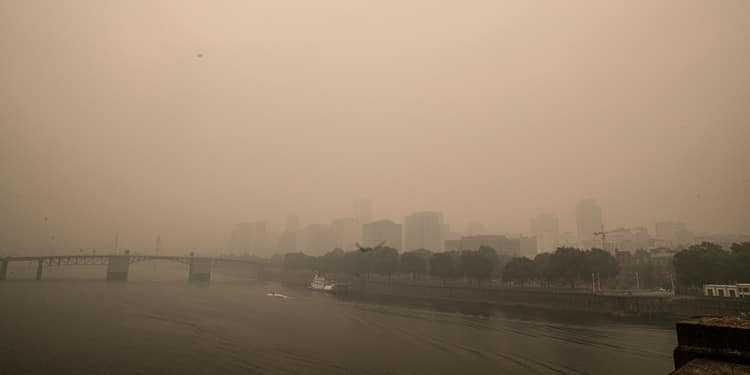With climate change more in our faces than ever before, find out what Portland-area kids are learning in the classroom about environmental issues.

If you live in or near Portland, there’s a good chance you needed to curtail your activity (and your kids’) in order to avoid inhaling too much smoke last September. Maybe you had fans running with wet towels draped over them, and looked out your windows into an unsettling, gray world, with the sun — if you could see it at all — appearing a dull, angry red. Or maybe you actually had to evacuate your home. Maybe your house was burned. Maybe a landscape you love that held irreplaceable memories — first kisses, childhood camping trips — is now charred and ashen. This year’s fire season isn’t over, and already we’ve had two heat-dome events. And then there was that crazy ice storm. Things are shifting. If you have relatives on an island, climate change has been terrifyingly real for you for a long time. These last two years, it’s been coming home to the rest of us.
If climate change keeps you up at night, here is one piece of good news: Portland-area schools are working really hard to do a good job teaching our children the science and the global human realities of climate change, and how it can be reversed.
Climate Change is a Racial-Justice Issue
In 2016, a group of teachers and students convinced the school board to pass a resolution on climate justice, calling for a focus in teaching about “people from ‘frontline’ communities, which have been the first and hardest hit by climate change.”
Treothe Bullock teaches chemistry at McDaniel High School on the Marshall campus. He’s also on the committee tasked with implementing the resolution, a work-intensive process that is still ongoing. While much has been accomplished, including the hiring of a full-time climate justice manager, there’s still a lot to do, like bringing teachers together to share exemplary climate justice curriculum with each other.
“Racial justice and climate change are not separate topics,” Bullock notes. “What is allowing the current wholesale disruption of our ecosystem is the idea of peoples who can be sacrificed. This is a racist strategy underlying the devastation of regions and peoples. You can’t separate the challenges of recovering from climate destruction and the challenge of dismantling racism.”
Bullock implements that call in his science teaching by organizing an annual climate justice fair, in which each sophomore chooses an individual affected by climate change, and then makes a report to represent that individual’s community. Students first present the chemistry involved in the damage this community is suffering through climate change. Then, students show what that community is doing to change that and how they can be supported. At the fair, sophomores present to freshmen, creating a peer-teaching dynamic. “It’s way more research than the teachers could do,” Bullock says, “and it lets students pick someone who looks like them, or is connected to their local community.”
The climate justice resolution has emboldened him as a teacher, Bullock adds, because its language encourages students to see themselves as environmental justice activists. As the planetary climate strikes began in 2019 and students started to participate, they were penalized for missing school. “Historically, if you didn’t come to class you were not allowed to participate in extracurriculars or sports,” says Bullock. But since the resolution passed, “the district has worked with the state so that students can get permission from their parents for community engagement and have an excused absence, so they are not excluded from sports, and can be excused from final assessments given on that day.”
The Student Perspective
Isaiah Conifer Irving, who is 15, attends Corbett High School, just up the Columbia River Gorge from Portland. He feels like teachers have been gradually discussing climate change more and more. But aside from his environmental science class, he says most of the mentions of climate change are passing. “Mostly what teachers say is ‘climate change is a thing and it’s happening,’ but they don’t go into many details. It seems to be up to individual teachers whether they teach it. Seems like the administration is interested in it, but doesn’t require it. But I’ve never been taught in school that climate change is not real.”
Irving says his most memorable experiences learning about climate change in school came from his English and social studies teacher, Tim Cooper. “He would often bring up current news at the beginning of class, and bring the class up to date on what was happening in the world. And he gave details. When he talked about climate change, he’d show us videos of giant icebergs calving.” (In case you are not up on your glacier terminology, an iceberg ‘calves’ when a chunk breaks off and falls into the water.)
He also has memorable family experiences learning about ecology. (Irving’s mom is the award-winning author of The Gospel of Trees.) “Really, just going on walks in the woods and talking about what is around us,” he says. “Woods are great. Although kids can often be reluctant to go on a walk in the woods.”
Students’ Health — and the Planet’s Health
Also outside of Portland Public Schools’ jurisdiction, but highly active in climate change education, is Patrick Walsh, who teaches social studies at Catlin Gabel School. He is at work on a small carbon sink on the school grounds. It will contain 600 trees and native plants, which absorb and store carbon, thus removing it from the atmosphere. Walsh says that climate education needs to take care to consider students’ mental and emotional health.
“Teenagers are good at smelling BS,” Walsh notes. “They really don’t need us to say ‘climate change is a big deal.’ And they really don’t need us to say ‘this is your generation’s problem to solve.’ So in my teaching, I try to focus on solutions. I start with a brief summary of where things are now. And honestly, I have to pull a lot of them back from the brink, and say ‘this is not quite as bad as you think it is.’ A lot of them really think the earth is going to be destroyed in their lifetime.”
“Systemic racism hits students in different ways, depending on their backgrounds and situation. And I think it’s the same with climate change,” Walsh continues. “If you are a Pacific Islander, and the place you call home is beginning to disappear as sea levels rise, that matters for how we should be teaching you.”
A Spiritual Connection to the Earth
Over at Franciscan Montessori Earth School in Southeast Portland, the school’s 10-acre campus is full of gardens, which play an integral role in its curriculum, from the preschoolers to the eighth graders. “Daily, students utilize the talents of our ‘garden specialist,’ who has helped to create and curate our extensive gardens that allow study of different micro-environments,” says advancement director, Michael Winning. “As an example, we have a Native American garden with indigenous plants from North and South America.”
The school’s teaching philosophy blends the ideas of the Italian doctor-turned-educator Maria Montessori, and the spirituality of the (also Italian) 13th-century monk Francis of Assisi, with the goal of guiding students “to respect themselves and others, and to be stewards of the Earth.”
Montessori, says Winning, “was keenly aware of the physical needs of humans, and blended into her lessons the fact that our continuing, healthful, stay on Earth is directly linked to the health of the planet and all of the interrelated ecosystems. She also focused on the web of life on Earth, and the fact that everything we do is somehow linked to our connection with the Earth and its inhabitants.” St. Francis is a good match for Montessori. He is said to have preached sermons to birds, and referred to the sun as his brother and the moon as his sister.
Even in Portland Public Schools, some of the teaching on ecology and conservation includes spiritual perspectives. For at least 10 years, the state of Oregon has required classrooms from kindergarten to grade 12 to have an Indigenous presenter at least once a year. St. Francis’ language would not be out of place in many tribal descriptions of the earth. These include descriptions of Native peoples working with fire, which was key to their relationship with the land. They used it every five to seven years, deliberately, to reshape landscapes. Even something as dangerous as fire can be treated as something that has gifts for us. And that is what a lot of education is about: shaping what we are capable of imagining. Here’s to learning to imagine climate justice.
- Family-Friendly Yoga Studios in Portland - January 1, 2024
- 11 Family-Friendly Bookstores in the Portland Area - November 6, 2023
- Portland’s Youth Performing Arts Spring Lineup - April 6, 2023






